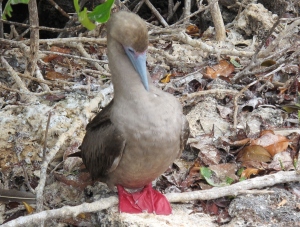
Red-Footed Booby
Isolated in the Pacific Ocean some 1,000 kilometres off the coast of South America, the Galapagos Islands are a living museum of evolution and home to some of the most unusual species in the world.
My wife Gail and I could see the arid landscape of salt bushes and prickly pear cacti as our jet began its descent to Isla Baltra where we were about to begin a 7-day cruise through the eastern islands of the Galapagos.

Your intrepid explorers in the Galapagos
It was early December, and we had arrived just as the warmer, rainy season was beginning and green buds were starting to appear on the dry foliage. “This is one of my favourite months of the year,” said our guide, who had picked us up at the airport, loaded us into a small Zodiac vessel, and ferried us to our ship that was anchored in the bay. “The seas are getting calmer, the underwater visibility is getting better, and the mating season for our wildlife is getting underway.”
Considered one of the world’s best destinations for getting close-up views of wild-life, the isolated terrain in this volcanic archipelago provides the perfect breeding ground for a range of rare plant and animal species. Its ongoing volcanic activity, its geographical location at the junction of three ocean currents (including the Humbolt), and its extreme isolation has given the Galapagos one of the richest marine ecosystems in the world, and led to the development of unique plant and animal life – such as marine iguanas, giant tortoises, and the many different subspecies of mockingbirds and finches.
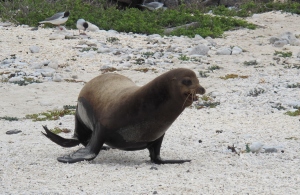
Galapagos Sea Lion
In fact, when the English naturalist Charles Darwin arrived here aboard the Beagle in 1835, he was inspired by what he saw, which led to his theory that species were not fixed, but evolved according to their environment. In particular, he observed how local finches had adapted into 15 different species based upon the different conditions in the islands they inhabited.
During the five-week period that the Beagle sailed among the Galapagos Islands, Darwin wrote “the natural history of this archipelago is very remarkable: it seems to be a little world within itself, the greater number of its inhabitants, both vegetable and animal, being found nowhere else.”

A pair of immature Great Frigate birds
As we boarded the Silver Galapagos, an intimate expedition ship that carries just 100 passengers, we were given a glass of champagne and escorted to our 235-square foot cabin that features a veranda with two chairs and a table. The veranda was a God-send as we would spend many hours on it soaking in the beautiful scenery in between shore excursions. And our location on the 4th deck was ideal – the same level as the piano bar and one below the outdoor bistro.
After a wonderful, late-night dinner at the Outdoor Grill overlooking a star-filled sky, we retired for the evening and awoke the next morning anchored off the coast of the island of Genovesa.
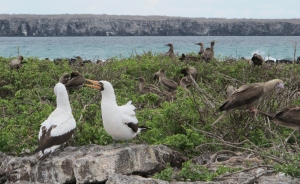
Nazca Boobies do the mating ritual
The first tour of the day departed at 8:00 am and took us by Zodiac to Darwin Bay where we did a wet landing on the sandy beach and embarked on a 90-minute nature tour. We were soon greeted by sea lions, Great Frigate birds, Brown Pelicans, Nazca Boobies, and one of the largest nesting colonies of Red-Footed Boobies in the world. Because the mating season had just begun, we were able to witness the mating ritual of these boobies, which includes short dances, the male displaying his blue throat, and nipping each other on their beaks.
We also saw Yellow-Crowned Night Herons feeding near tidal lagoons, and Swallow-tailed Gulls nesting in the nearby cliffs. And we loved watching the adult Boobies returning from the ocean with flying fish and squid in their beaks to feed their off-spring.
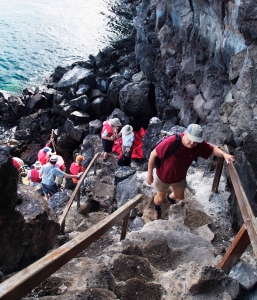
Prince Philip’s Steps on Genovesa Island
Like all but four of the 20 Islands in the National Park of the Galapagos, Genovesa is unpopulated and visitors are restricted to narrow pathways and are not permitted to get closer than a few feet to any of the wildlife. As a result, most of the birds, marine life and tortoises in the islands are not afraid of humans, which allowed us to get incredibly close to them and take wonderful photos.
After an Al Fresco lunch back on the ship where we sampled local cuisines such as Ecuadorian shrimp ceviche at the Outdoor Grill, we embarked on our second Zodiac excursion of the day, this one to Prince Philip’s Steps, named to commemorate the Duke of Edinburgh’s visit to the island in 1965. As we jumped off the Zodiac onto a steep, uneven path to ascend 25 meters from the water to the top of a cliff, we saw Storm Petrels, Swallow-tailed gulls and Red-billed Tropic birds flying overhead, and dozens of Sally Lightfoot red crabs crawling across the rocks.
At the top of the cliff, our tour guide led us inland along a marked trail through an area of palo santo trees and alongside colonies of Red-footed Boobies nesting in the trees, and Nazca Boobies and Great Frigate birds on the ground. At the end of the trail, we eventually reached a rocky lava plateau overlooking the cliff edge and ocean where we watched Storm Petrels skimming across the ocean surface in search of food, sometimes being chased by Great Frigate birds trying to steal any fish they had caught.
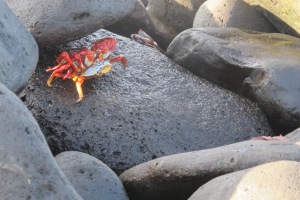
Sally Lightfoot crab
After our two-hour tour, we returned to our ship by Zodiac, enjoyed a glass of wine on our balcony, and got ready for dinner in The Restaurant, which serves as the main dining room and is located on Deck 2. The Restaurant, which is open for breakfast, lunch and dinner, is casually elegant, with light wood tables and chairs and soft banquettes. It has an open seating policy, which meant we were free to enjoy our meals when we wanted, and with whom we preferred to dine. And the wine was complimentary, as are most alcoholic beverages on the ship.
As there are strict rules on importing food into the Galapagos from outside Ecuador, most of the cuisine is sourced locally, which means it is all very fresh, especially local fish and seafood. For dinner, which is served between 7:30 and 9:00 pm, the menu typically offers three-course meals that include international dishes such as filet mignon, rib-eye steak, roasted pork and vegetarian options, as well as local Ecuadorean specialities like tuna ceviche, Galapagos Lobster à la Galapaguera, and Red Snapper.
We slept well after a splendid dinner, and awoke the next morning to find our ship had sailed 62 nautical miles to Seymour Norte, a small island teaming with wildlife below and above the water’s surface.
In my next blog post, Gail and I explore Seymour Norte and nearly 10 other ports of call as we complete our 435 nautical mile voyage through the beautiful waters and islands of the Galapagos National Park in Ecuador.

Feature image – the Silver Galapagos expedition ship in Darwin Bay
Categories: Travel

Hello David, great article on a destination we are considering. Would you accept sharing a few tips with a former colleague at RBC? Warm regards. Claude
LikeLike
Hi Claude. I’ve sent you an email and I look forward to speaking with you about the various options available to tour the Galapagos.
Regards,
– David
LikeLike